|
05/05/2012. A quick look at the Solar Dynamics Observatory's images this morning suggested it would be worth waiting for a clear spell and having a look for myself. The 304A image sometimes gives a good clue when spectacular prominences rise from the solar limb and hot spots at that wavelength are often very detailed in hydrogen-alpha. Even through clouds, I made out a tall eruptive prominence. It changed appearance dramatically between first and second looks, and a review of the SDO data says I missed the best of it. Still, what I saw was pretty good:
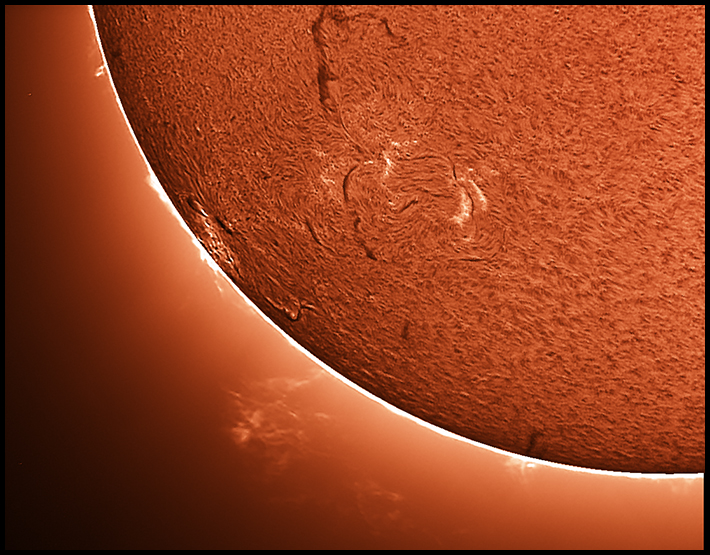
Limb: 300 x 48ms
Surface: 886 x 8ms
The sky cleared over the next hour and allowed this clear look at a supersized Scylla & Charybdis:
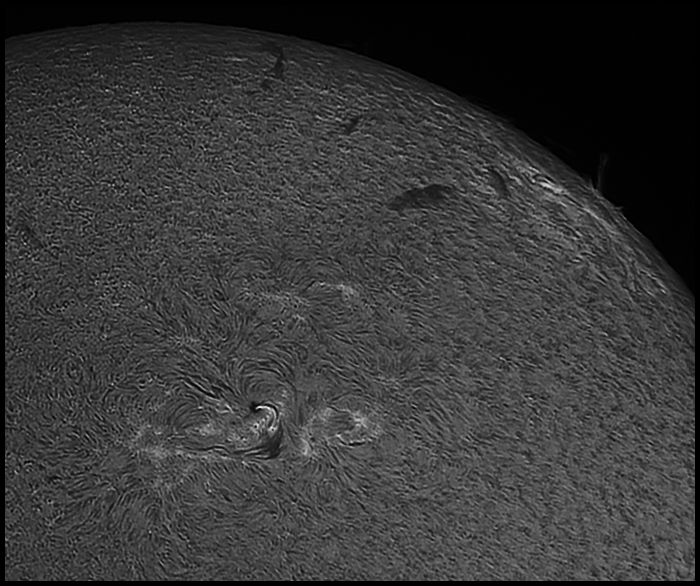
886 x 4.7ms
Some of this is for practice: the transit of Venus is one month away and I want solar imaging at this level of detail to be second nature, haze, broken clouds, or whatever comes.
5/06/2012. I unmounted the Ritchey and mounted the A-P 5-inch refractor side by side with the Lunt solar telescope in preparation for the upcoming transit of Venus. My thought at the moment is to use the 5-inch with its Thousand Oaks solar filter for looking and the Lunt double-stacked for narrow-band imaging with the Point Grey Chameleon. I'm thinking about a neighborhood outreach evening. After shooting the portrait below, I put the 35mm Panoptic on the A-P. It's a wide enough field that the entire Sun is nicely visible no matter what part of the Sun is centered in the Lunt. I may try the telecompressor on the A-P and a different eyepiece and I may adjust the Lunt's bracketry to more closely align it with the A-P (and with the AT Ritchey, for that matter). I unlocked the Robofocus motor so that the A-P can be focused manually for various eyes. Here's the kit during its first sky trial:

There's an active region coming around the NE quadrant of the Sun just now (see color photo above and b/w below, nevermind the reversed orientation) flinging multiple M-flares each day. I'll need to note what's happening on June 5 - 27 days = about day after tomorrow to see what part of the Sun will lie behind Venus when the day comes.
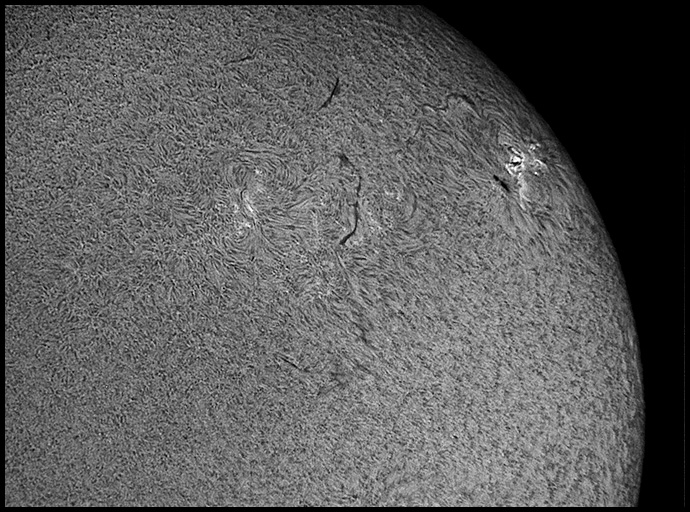
300 x 6ms
I worked out the speed of Venus's apparent motion with respect to the Sun, and it comes to less than 3 arc seconds per minute of time. So I can use my usual 300 frame, 20s clip and record no more than one arc second of blurring due to the revolutions of the spheres. I should be so lucky that that would matter to the finished image.
5/07/2012. Some more tests today. Sun006.avi (et seq) is about 2,000 frames at 5ms and 15db of gain; Sun008.avi followed immediately and is 300 frames @ 25ms and 0db gain; Sun009.avi was also captured immediately after the previous clip and is 300 frames @ 3.6ms and 15db gain.
Of these, the cleanest is Sun008, followed by a 1GB sample from Sun006. Sun008 does not require the despeckle pass prior to Focus Magic's deconvolution. That extra step inevitably costs some fine detail but is required to keep deconvolution from blowing up the grain in a noisy clip. Useful dynamic range is improved, too. The 1 GB (886 frame) portion of Sun006 is much cleaner than Sun009 but it still needs noise reduction prior to deconvolution. The obvious next trial is a long-run clip at zero gain. It won't really tell much in advance of the transit (because 20s is about as long as I want to let the planet move), but it may be very useful for improved solar detail. More as I learn more.
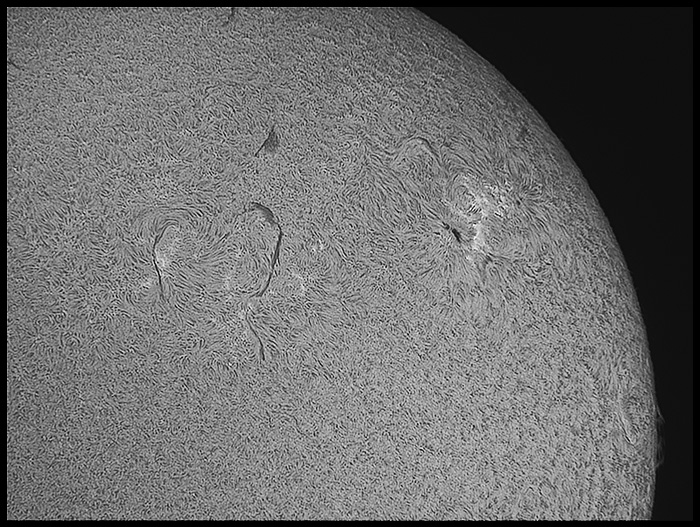
300 x 25ms (0 gain)
5/08/2012. In a brief spell of bright sunlight between clouds in the morning and rain in the evening, I took video of the same active region using various schemes: shortest possible exposures, my usual short exposures at modest gain, zero gain, and a compromise at relatively low gain:
2.5ms @ 16 db
4.5ms @ 13 db
16ms @ 6db
25ms @ 0 db
When all is said and done, I think today that the 16ms sequence reduced best. The 2.5ms runs look best as video (the "grain" disappears in the atmospheric motion and the images seem crisper).
Important insight of the day: don't underexpose! This is just like any other digital photography after all: if you have to pull detail up from the left side of the histogram, you are bound to pull a lot of noise up with it. So expose generously and use the lowest gain (i.e., the lowest ISO) you can. You ought to know that by now. The best exposure on any given day will depend some on what kind of seeing dominates (the worse the seeing, the faster the seeing, the bigger its amplitude, the shorter the exposure that will be needed to get the best detail). That only stands to reason, doesn't it? Think of the other end of things: if there were no seeing to defeat, I'd use the longest practical exposure at the lowest practical gain. If a 16ms exposure will freeze the seeing, use it. If a 50ms exposure is short enough to stop atmospheric motion, use that. If it takes a 3ms exposure, well, crank the amplifier, use the short exposure, and collect plenty of frames because noise decreases as the square root of the number of frames (right?).
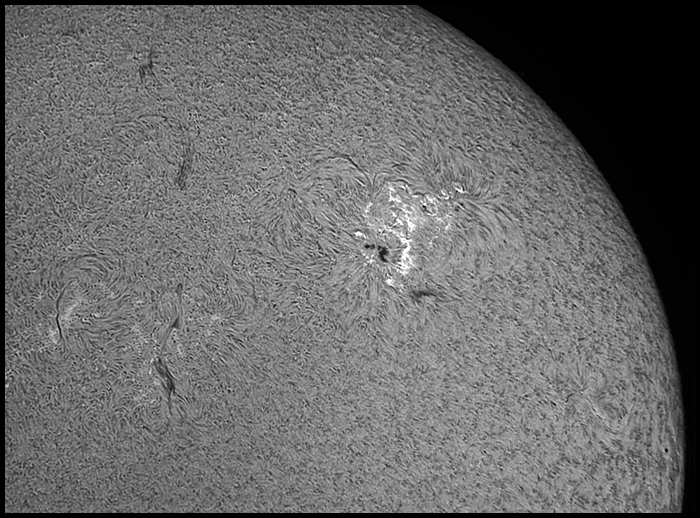
AR1476
886 x 16ms, 6db
5/10/2012. AR1476 is surrounded by almost constant C-level flares. Now and then it is encircled by a ring of high B activity, and hot-spots on that ring frequently brighten into the C-flares just short of M-classification. In fact, there have been five M-class events within 48 hours. I watched one this afternoon. On the second monitor, while clouds passed by, a single bright spot appeared. When the clouds moved on, the active region was punctuated by a brilliant M-class burst, still brightening. I got a decent photo which Spaceweather.com linked, and which shows not only the M-flare (v-shaped spot at upper right of the umbra) but strands of brilliant activity:
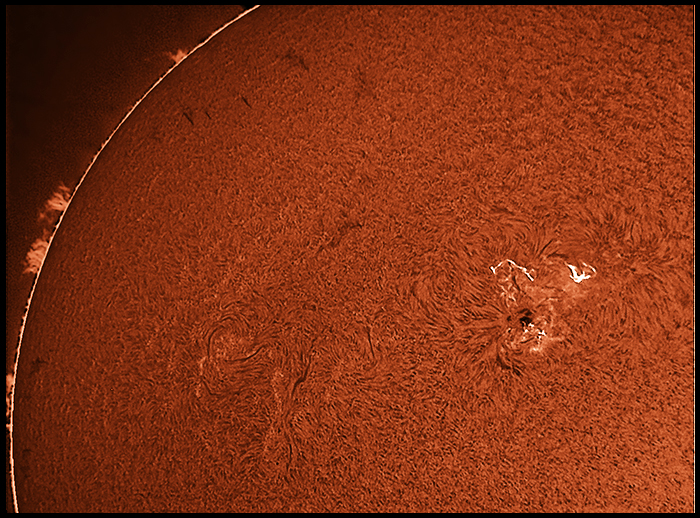
300 x 8ms, 6db
limb and disk processed
separately then recombined
Except where noted, solar photos are made with a Point Grey Research Chameleon camera behind a Lunt Solar Systems 60mm THa solar telescope double-stacked wtih a 50mm front etalon for an achieved bandwidth of about 0.55 Angstroms. The telescope uses a B600 blocking filter and is mounted piggyback with an Astro-Tech 10-inch Ritchey-Chretien (carefully capped!) on an Astro-Physics Mach1GTO mount. An Acer Aspire One netbook running Point Grey's Flycap software provides camera control and capture services via USB 2.0. Images typically begin as 20 second AVI's captured at 15 fps. 300 frame clips are aligned and stacked using Registax 6 or AVIStack 2.0. The resulting files are processed via wavelet functions in Registax and / or the FocusMagic 3.0.2 deconvolution plug-in in Photoshop CS4. (PixInsight is rapidly supplanting some of those steps.) The imaging train usually includes an Orion "Shorty" 2x barlow screwed into the 1.25-inch prime-focus snout. Exposures are on the order of 4-8 ms with gain set to 10-12 db, or 12-18ms at 0 gain. The barlow is sometimes replaced by an Antares 0.5x telecompressor sandwiched between the 1.25-inch snout and the C-adapter on the PGR Chameleon; this produces a full-disk image (during most of the year) and allows exposures in the 1ms range with slightly less gain. A RoboFocus motor with a timing belt looped around the stock (or, sometimes, a Feathertouch) focus knob enables remote operation.
|